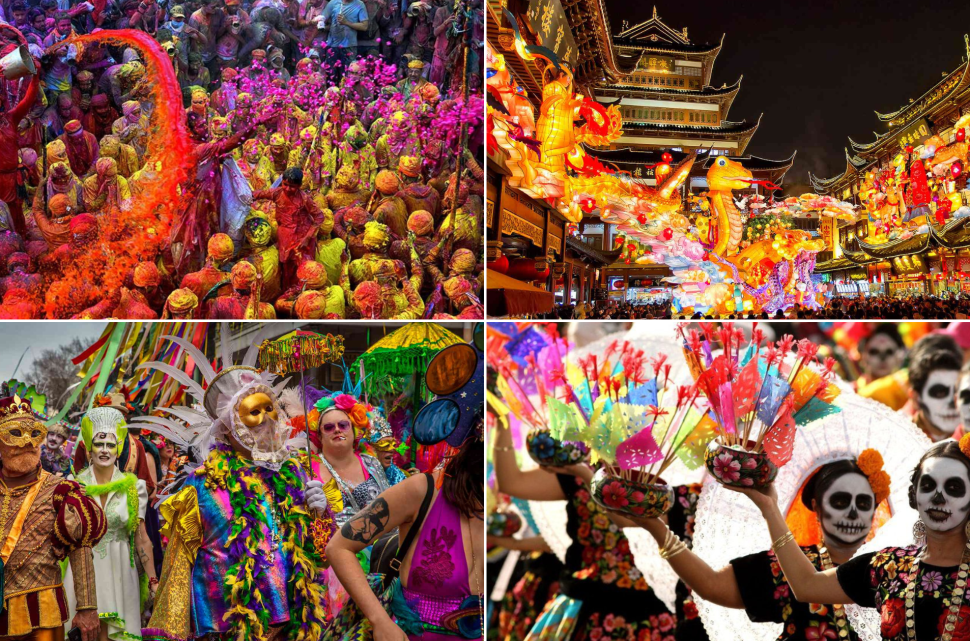Introduction
Culinary tourism has become a significant trend in the travel industry, with food playing a central role in enhancing travel experiences. Beyond sightseeing and cultural immersion, exploring different cuisines, indulging in street food adventures, and participating in culinary festivals offer travelers a unique and flavorful way to connect with local cultures and traditions.
Here’s a closer look at the role of food in travel experiences:
1. Exploring Different Cuisines:
Exploring different cuisines is a delightful journey that involves discovering the diverse flavors, ingredients, and cooking techniques of various cultures around the world. It goes beyond simply tasting new dishes; it’s an immersive experience that provides insights into the history, traditions, and lifestyle of different communities. Trying dishes from different cuisines introduces the palate to a spectrum of flavors, from the spicy and aromatic profiles of Asian cuisine to the rich and hearty comforts of European fare. Exploring street food markets, local eateries, and fine dining establishments allows individuals to appreciate the creativity and artistry that chefs bring to their culinary creations. This culinary exploration fosters a sense of global connection, celebrating the universal joy of sharing delicious food while broadening one’s understanding and appreciation of the world’s cultural diversity.
2. Street Food Adventures:
street food adventures is a vibrant and immersive way to explore the heart and soul of a city’s culinary scene. It involves navigating bustling markets and lively streets to discover an array of authentic, locally-prepared dishes. Street food reflects the unique flavors and culinary traditions of a region, offering a diverse and often affordable gastronomic experience. From savory snacks to sweet treats, street food vendors showcase the cultural diversity of global cuisines, allowing adventurous eaters to sample specialties that may not be found in traditional restaurants. Street food adventures also provide an opportunity for spontaneous interactions with locals, creating a shared experience around the joy of discovering delicious and often hidden gems within the dynamic tapestry of a city’s culinary landscape.
3. Culinary Festivals:

Culinary festivals are immersive celebrations of gastronomy that bring together food enthusiasts, chefs, and vendors to showcase diverse cuisines, culinary innovations, and local flavors. These events often feature a rich tapestry of culinary experiences, including cooking demonstrations, tasting sessions, and opportunities to interact with renowned chefs. Culinary festivals serve as platforms to explore regional specialties, street food delights, and cutting-edge culinary trends, providing a dynamic environment for food lovers to indulge their palates. From seafood extravaganzas to wine and cheese festivals, these events contribute to fostering a sense of community and appreciation for the culinary arts. Attendees have the chance to engage with food producers, learn about sustainable practices, and immerse themselves in the cultural and social aspects of food, making culinary festivals a delectable blend of education and entertainment.
4. Cooking Classes and Workshops:
Cooking classes and workshops offer individuals the opportunity to enhance their culinary skills, deepen their understanding of ingredients, and explore diverse cooking techniques. Led by professional chefs or culinary experts, these sessions provide hands-on experiences that range from basic cooking fundamentals to specialized cuisines. Participants often learn about flavor profiles, knife skills, and the art of presentation, gaining practical insights that empower them to recreate delicious dishes at home. Cooking classes are not only educational but also foster a sense of community, as participants share a common passion for food and cooking. These workshops can cater to various skill levels, from beginners seeking fundamental skills to experienced cooks looking to master advanced techniques. The interactive and social nature of cooking classes creates a convivial atmosphere, making them a popular choice for those seeking to elevate their culinary prowess in an engaging and collaborative setting.
5. Connection and Cultural Understanding:
Food is a universal language that transcends borders, and sharing a meal can foster connections and understanding between people of different backgrounds. Sitting down for a meal with locals or fellow travelers provides an opportunity to engage in meaningful conversations and learn about shared experiences, traditions, and values. culinary tourism enriches travel experiences by allowing individuals to engage with a destination’s culture through its food. Exploring different cuisines, embarking on street food adventures, participating in culinary festivals, and engaging in cooking classes all contribute to a deeper understanding of a region’s history, traditions, and way of life. As travelers seek authentic and immersive experiences, the role of food in travel continues to grow, making culinary exploration an essential aspect of modern tourism.
6. Gastronomic Tourism:
Gastronomic tourism, also known as culinary tourism, is a travel trend that revolves around exploring and experiencing a destination’s culinary offerings. It goes beyond traditional sightseeing, placing a strong emphasis on sampling local dishes, visiting food markets, and engaging in cooking classes or tastings. Travelers embark on gastronomic journeys to immerse themselves in the flavors, aromas, and traditions of a region, often seeking authentic and locally sourced culinary experiences. Gastronomic tourism contributes to the economic growth of local communities, highlighting the significance of food culture in shaping a destination’s identity. From savoring street food to dining at renowned restaurants, this form of tourism offers a multisensory exploration of a location’s cultural heritage, creating memorable and enriching travel experiences for food enthusiasts worldwide.
7. Food Markets and Local Producers:
Food markets and local producers play a vital role in shaping culinary landscapes, offering a vibrant tapestry of fresh produce, artisanal goods, and regional specialties. These markets serve as cultural hubs where locals and visitors alike can engage with the community, explore diverse flavors, and discover the essence of a destination’s food culture. From bustling street markets to quaint farmers’ markets, these spaces showcase the richness and diversity of local ingredients, often sourced directly from nearby producers. Beyond the array of fresh fruits, vegetables, and spices, food markets provide an opportunity to support local artisans, bakers, and farmers. Many markets also host food festivals or cooking demonstrations, creating a dynamic atmosphere that fosters a deeper connection between consumers and the origins of their food. Exploring food markets and connecting with local producers offers a sensory and immersive experience that is integral to understanding the culinary identity of a region.
8. Fusion and innovation:
Fusion and innovation in the culinary world involve the creative blending of diverse culinary traditions, techniques, and ingredients to produce unique and unexpected flavor profiles. Chefs and culinary enthusiasts experiment with combining elements from different cultures, often resulting in exciting and inventive dishes that defy traditional categorization. This trend has gained popularity as it allows for the exploration of new taste sensations and the breaking of culinary boundaries. Fusion cuisine can merge ingredients and techniques from various parts of the world, offering a fresh perspective and stimulating the palate with unexpected harmonies. Innovation in the culinary realm extends beyond fusion, encompassing avant-garde cooking methods, molecular gastronomy, and sustainable practices, all contributing to the evolution of culinary arts. The dynamic interplay between tradition and experimentation showcases the culinary world’s capacity for constant reinvention and reflects the global interconnectedness of diverse food cultures.
9. Food Trails and Culinary Routes:

Food trails and culinary routes are curated journeys that take food enthusiasts on a gastronomic adventure, highlighting the diverse and authentic flavors of a region. These trails often lead participants through a series of eateries, markets, and local food producers, offering a comprehensive and immersive experience. Whether exploring the street food delights of a bustling city or the farm-to-table offerings in rural landscapes, food trails celebrate the culinary identity of a destination. They provide a platform for discovering traditional dishes, regional specialties, and the stories behind the food, creating a rich tapestry of cultural and gastronomic exploration. Culinary routes may also incorporate historical and cultural landmarks, intertwining the appreciation of food with a broader understanding of a region’s heritage. The popularity of food trails reflects a growing interest in experiential travel, where the journey becomes as significant as the destination, allowing participants to savor the essence of a place through its unique culinary offerings.
10. Sustainable and Ethical Dining:
Sustainable and ethical dining represents a conscientious approach to food consumption that prioritizes environmental and social responsibility. Restaurants embracing this philosophy focus on sourcing local, seasonal, and organic ingredients, reducing food waste, and employing eco-friendly practices. Ethical dining extends beyond environmental considerations to address fair labor practices, humane treatment of animals, and community engagement. Many sustainable restaurants collaborate with local farmers and artisans, supporting a resilient and ethical food ecosystem. The movement also encourages transparency in supply chains, allowing consumers to make informed choices aligned with their values. As diners increasingly seek conscious dining experiences, sustainable and ethical practices are not only seen as a mark of responsibility but also contribute to a more holistic and harmonious relationship between food, communities, and the planet.
11. Food as a Cultural Expression:

Food serves as a profound expression of culture, acting as a culinary language that communicates traditions, values, and the unique identity of a community. Each dish becomes a story, reflecting historical influences, local ingredients, and the creative spirit of a culture. The preparation and sharing of meals hold deep symbolic meanings, fostering a sense of belonging and connection within a community. From elaborate feasts during celebrations to daily rituals around the dining table, food becomes a cultural expression that transcends geographical boundaries. Traditional recipes handed down through generations carry the wisdom and heritage of a culture, creating a tangible link between the past and present. Exploring the culinary landscape of a region provides a sensory journey into its cultural narrative, allowing individuals to appreciate the diverse ways in which communities express themselves through the art of cooking and sharing meals.
12. Documenting Food Journeys:
Documenting food journeys has become a popular and engaging activity, blending the pleasures of culinary exploration with storytelling and visual expression. Social media platforms, blogs, and dedicated food apps provide individuals with the means to share their gastronomic adventures with a global audience. Food enthusiasts capture the essence of their culinary experiences through photographs, videos, and detailed narratives, offering insights into diverse cuisines, local specialties, and hidden gems. Documenting food journeys goes beyond showcasing dishes; it often involves sharing the cultural context, personal anecdotes, and the emotional connection forged with each meal. This digital storytelling has created a vibrant online community where food lovers exchange recommendations, celebrate culinary diversity, and inspire one another to embark on their own flavorful journeys.
conclusion
culinary tourism is a multifaceted exploration that extends far beyond just eating. It encompasses diverse activities, from visiting local markets and engaging in sustainable practices to uncovering food-related traditions and celebrating innovation. By immersing themselves in the culinary fabric of a destination, travelers can create meaningful connections, deepen cultural understanding, and cultivate lasting memories that go beyond the plate.




